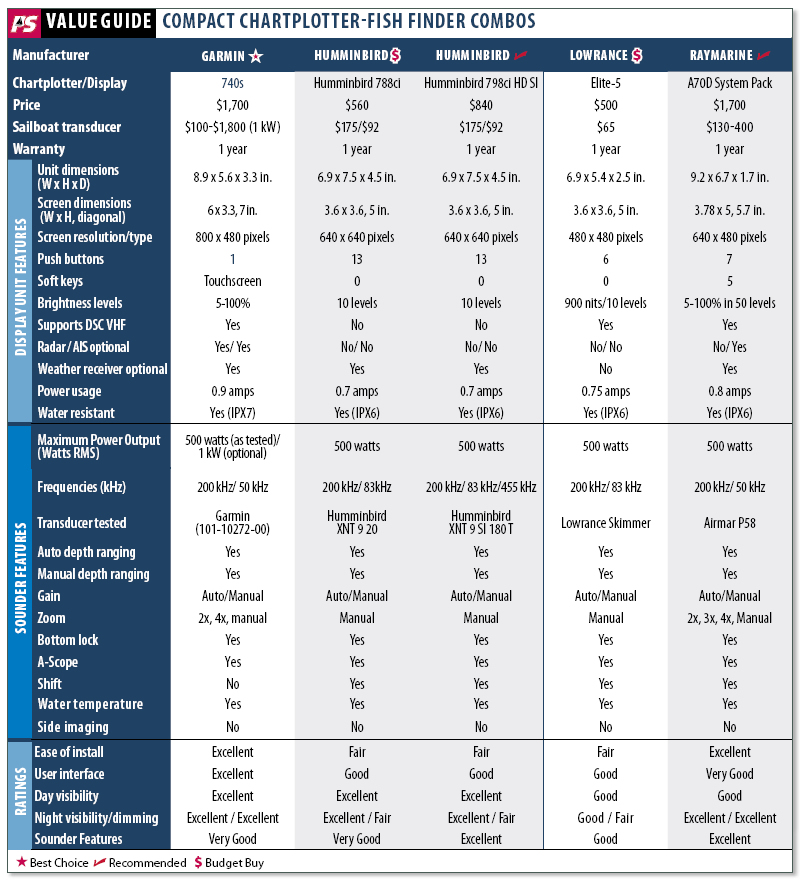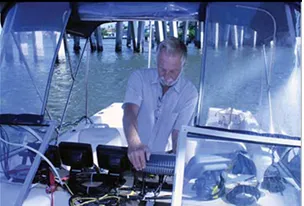
304
Last month, we compared the chart-plotting features of four small-screen plotter-sounders from Garmin, Humminbird, Lowrance, and Raymarine. The article focused on the features that are most critical in a chartplotter: navigational functions, intuitive interface, and the ability to network with other onboard electronics. In that comparison, the touchscreen Garmin 740s stood out with its easy touchscreen interface, optional radar, and “big” 7-inch diagonal screen. This month, we take a closer look at the fish-finding functions.
What We Tested
For this comparison, we looked at five units priced from $500 to $1,500. The high-end products in this test were the Raymarine A70D and the Garmin 740S. Both units have bigger, high-resolution screens, both could handle the latest 3D charts, and both were designed to network easily with wind instruments and autopilots. (The A70D will soon be replaced by the e7, Raymarine’s new touchscreen/rotary dial chartplotter sounder, which PS will be testing early next year.)
The smaller screens in our comparison were the Lowrance Elite-5, the Humminbird 788ci, and the Humminbird 798ci SI. All three have 5-inch diagonal screens and are aimed mostly at anglers.
None of the units we tested are compatible with the new broad-frequency transducers developed by Airmar, a high-definition, fish-finding technology aimed at the serious fishing crowd.
How We Tested
We ran each unit through day and night screen visibility testing as well as a full series of functionality checks to see how they handle sounder chores. Displays were rated under a variety of lighting conditions that included bright sunlight, cloudy skies, twilight, and night-time conditions. Testers evaluated chartplotter user-interface by performing various actions like creating waypoints, building routes, changing map ranges, and varying the chart orientation. The ratings for these and other plotter-related tests appear in the accompanying Value Guide and are reported in greater detail in our November 2011 issue.
Each sounder was rated for both presentation and usage while following a test track on the Intracoastal Waterway (ICW), and doing spot soundings over structure in the Gulf of Mexico at depths of up to 40 feet. Speed during ICW testing was approximately six knots and depths varied from six feet to 12 feet. Water clarity was about 3 feet. Water temperature was in the low 70s.
All units were first tested under default “auto” settings at 200 kHz. Sounder images under these settings were examined for clarity. Testers later manually adjusted the primary settings such as gain, zoom, and color palette, and evaluated image clarity. Key features such as bottom lock were also tested underway, as were some pre-set modes for detecting fish or bottom structure. Total distance covered for each sounder test was approximately 2.5 nautical miles.
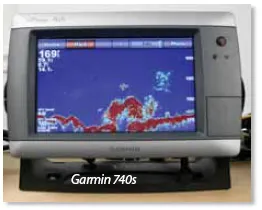
262
Garmin 740S
The Garmin 740s followed up its Best Choice showing in the plotter ratings with another excellent performance. Again, the unit’s exceptionally intuitive user-interface and big, bright, higher resolution screen helped tilt the scales in its favor. The default settings were well calibrated for our testing environment, with both schools of fish and bottom structure showing up clearly.
Installation is fairly straightforward, with a range of transducers to choose from. Garmin is the only unit in our test that could support an optional 1-kW transducer as well as the standard 500-watt transducer. This high-power transducer has the ability to penetrate murk and deliver better target definition in deeper water, but it costs $1,800. We used the standard 500-watt (root mean squared, RMS) transom-mount transducer, and it worked fine. Garmin offers an extremely wide range of matching transducers, including several through-hull models.
The sonar menu is smart-phone intuitive, allowing the user to quickly change important settings without cluttering up the screen with pop-up windows. The manual range of depth is easily accessible from the main sonar page, letting you quickly zoom in for a better picture of the bottom. Adjusting gain is not as quick and easy as it is with the Humminbird models, but pretty straightforward, requiring just two finger taps to reach the slider used to manually adjust gain. Although it does not have the “shift” function, which lets the user select a horizontal slice of the water column and keep bottom structure in proportion, the manual zoom function can be used for the same purpose with nearly the same results.
Like all of the units in this test, the Garmin allows multiple views of sonar data. Two standard views are the split-zoom view, allowing one-half of the screen to zoom in on the bottom; the other is the split-frequency view, showing images at both 50 kHz (generally used for deeper water) and 200 kHz (most effective in shallower water) on boats equipped with dual-frequency transducers.
Cold water sailors and fishermen should keep in mind that the capacitive touchscreen technology will not work with full-finger gloves.
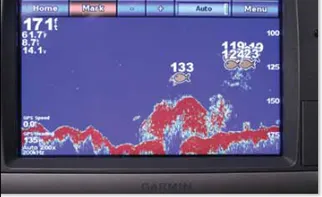
322
Bottom line: For the sailor who wants it all, including radar, in one compact multifunction display, the Garmin 740s is hard to pass up. Its dead-simple interface, bright display, and optional radar gives it an edge over the Raymarine A70D. The unit’s only obvious drawback is the magnet used to latch the chart card slot. We found it caused compass deviation in a handheld compass held within 12 inches of the unit. Garmin recommends a 36-inch buffer.
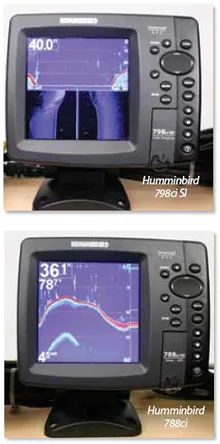
220
Humminbird 788CI and 798SI
One of the more exciting products we looked at in this round of testing was the Humminbird 798ci SI, the big brother of the 788ci featured in the plotter comparison. Both Humminbird units feature essentially the same chartplotter functions, but the 798ci takes advantage of a ramped-up processing speed to offer side-scanning capability. The 798ci SI uses an ultra-thin (455 kHz) beam to capture bottom details and fish up to 240 feet on either side of the boat. (To capture a cross-sectional slice of the water directly beneath the boat, the 798ci SI has another mode called Down Imaging.) The individual images are then processed to provide a continuous view of the bottom. To make the best use of this technology, you will want to find a mounting place, ideally ahead of the keel, that gives you a clear view of either side of the hull. The through-hull transducer adds about $200 to the total.
While side-scanning is an obvious advantage to fishermen, we were curious to see how it might help the average sailor. One application for this technology would be cruising the Intracoastal Waterway, or other areas of frequent shoaling. While it won’t catch shoals ahead in the same way forward-looking sonar does (see the PS test of Interphase SE-200 Sonar Engine in the April 2008 issue), accurate side-scanning could, theoretically, give you an idea of how far you are straying from the maximum depth.
During our testing in a stretch of ICW with a dredged section about 200 feet wide, we could clearly define “hard” obstructions on either side of the channel. Less obvious were the depth contours, particularly when the bottom in the side-scan gradually slopes. By adjusting the gain, however, the display became easier to interpret. The side images are only duo-chrome, and translating these images into real-world details requires some practice. The shadows, or blank spots, are often as informative as the returns themselves. We were able to clearly see pilings, oyster beds, mangrove islands, a narrow channel into a small boat basin, shoreline rip-rap, and channel markers using the side-imaging view. (See “Side-imaging Success.”)
This would also be a good tool for probing a new anchorage for foul ground, areas that are cluttered with debris, coral heads, big rocks, or abandoned moorings that might wrap an anchor rode. The 798ci HD SI also features what Humminbird calls “Switchfire,” which effectively turns off all of the filters so that you can examine the raw data in more detail and use manual filters to tweak the view as you like. Overall, we were impressed with the abilities of the 798ci, although it is overkill for those sailors interested in just depth and bottom profiles. The sounder is rated at 500 watts RMS.
Both the 788ci and the 798ci handle the other sounding chores similarly, and have similar capabilities. The default settings did well in our testing ground and accessing key adjustments, such as gain or zoom, was simple. Just press the menu button, and the gain adjustment menu pops up. By adjusting the gain, we were able to determine that about a foot of soft bottom, probably mud, covered a harder bottom, most likely clay, hard sand, or possibly rock. Rocks and oyster beds presented crisp returns. Both units have more than a dozen different page views—ranging from one to three panels on the screen at once. Each of the essential page views has its own sub-menus, so the interface is intuitive, although not as easy as the Garmin.
Bottom line: The side-imaging technology is a boon to fishermen, less so for sailors, but the overall performance of the Humminbird units was good. Either unit is Recommended for the avid fisherman who also sails.
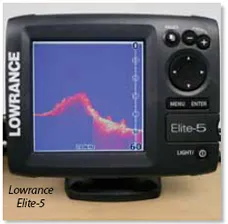
228
Lowrance Elite-5
Lowrance built its name around its sonar technology, so it is no surprise that the Elite-5 emphasizes fish-finding abilities. While an eminently tweakable fishfinder is a boon for the angler, it is somewhat less exciting to the sailor who just cares how deep the bottom is, or what the bottom looks like. We tested the Elite-5 using Lowrance’s “Skimmer” 500-watt, dual frequency (200/83 kHz, with temperature) transducer.
Using the “Auto” setting, the image was very cluttered, but it was reporting depth solidly. Testers had to turn the gain down to -20 to get a cleaner image. Screen visibility was good, and the bottom image was very clear once adjusted. After some initiation, the interface is fairly easy, particularly for manually zooming in on objects of interest. However, the small screen, combined with the multiple sub-menus, means that navigating through the various options can result in a complicated screen.
Once the gain settings were re-adjusted, the Lowrance did everything it was supposed to do. Its lower resolution, 480-by-480 pixel screen was only slightly less sharp than the other units in the test, all of which had higher resolution screens. One of the biggest drawbacks of this unit was its lack of installation options. Lowrance does not offer a through-hull transducer for the Elite 5, so a sailboat owner will have to opt for a shoot-through-the-hull installation—or move up to the Lowrance HDS-7.
Bottom line: The Budget Buy Elite-5 makes a fine entry-level plotter-sounder, but interface and limited transducer options hold it back in the sounder category.
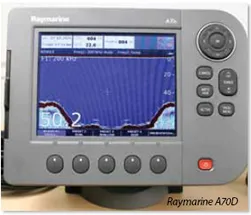
251
Raymarine A70D
The Raymarine A70D is the big brother of the A50D that Practical Sailor reviewed in June 2009, and it shares many of the same advanced features. Raymarine has just introduced its replacement, the new e7, a 7-inch multi-function display with both a touchscreen and a rotary-button backup that Practical Sailor will be testing. Production of the A70D is scheduled to end in December 2011, and Raymarine is offering $400 rebates through November 30, 2011. Units should be available through early 2012.
With the background set to classic blue, the Raymarine A70D did a flawless job defining and tracking the bottom. Like the Garmin 740s, it delivered a sharp, clear image. The transom-mount transducer was an Airmar P58 600-watt, 200/50 kHz with temperature sensor. Settings menus were straightforward and easy to access.
The A70D has four soft keys, whose functions vary according to the mode. The most noticeable advantage of the A70D’s soft-key arrangement in the sounder mode was the ability to customize four different pre-set sonar configurations. The default settings are single-frequency transducer, dual-frequency transducer, deep water, and shallow water, and users can modify these as they like. Fish were not as clearly seen with the “Auto” setting as other units, but bumping the gain up a bit helped. Installing the mounting bracket requires some fiddling, but it is fairly solid and easy to adjust. The default color schemes, coupled with a high-resolution display, delivered good screen visibility in daylight conditions.
Bottom line: Based on our initial impressions of the A70’s replacement, the e7, we think many users will prefer its more streamlined interface. However, the A70, which features a three-year warranty and will plug-and-play with Raymarine’s latest generation of autopilots, offers good value in this group. If you want to interface the A70D to older instruments like ST30, ST40, ST50 or ST60 series devices, you will need to add the PC/SeaTalk/NMEA interface box (E85001, $159).
Raymarine lists only a few expensive transducers for the A-series devices. However, an adapter plug (E66066, $79) lets you plug in a wide range of low to mid-priced sounders, including the P319 plastic through-hull low profile transducer, which retails for about $150. The Ray units use Airmar transducers, and some Airmar transducer distributors also offer a range of A-series-ready transducers suitable for sailboats with prices starting at around $130.
Conclusion
Our test criteria focused on the fundamental sounder functions, and all handled these without a hiccup using the default settings. As we found in our tests, each manufacturer has its own ideal default gain setting, so getting the best image—or pinpointing fish—may require some tweaking. Some more long-term testing would be needed to gauge durability, but based on our experience, any of these units would fulfill the basic sounder functions that a sailor needs.
As we found in our plotter test, the Garmin 740s stood out for its ease of use and bright screen. Its default settings were spot on, providing clear, easy-to-interpret images. The Raymarine’s soft keys added versatility, and in sounder mode, its interface matched the Garmin for simplicity. It is Recommended.
The bright screen and side-imaging technology in the Humminbird 798ci SI earned that unit a Recommended rating for the fisherman-sailor. While the Lowrance scored our Budget Buy recommendation for its chartplotter features, in this round, it fell below the Humminbird 788ci, which had more transducer options.
